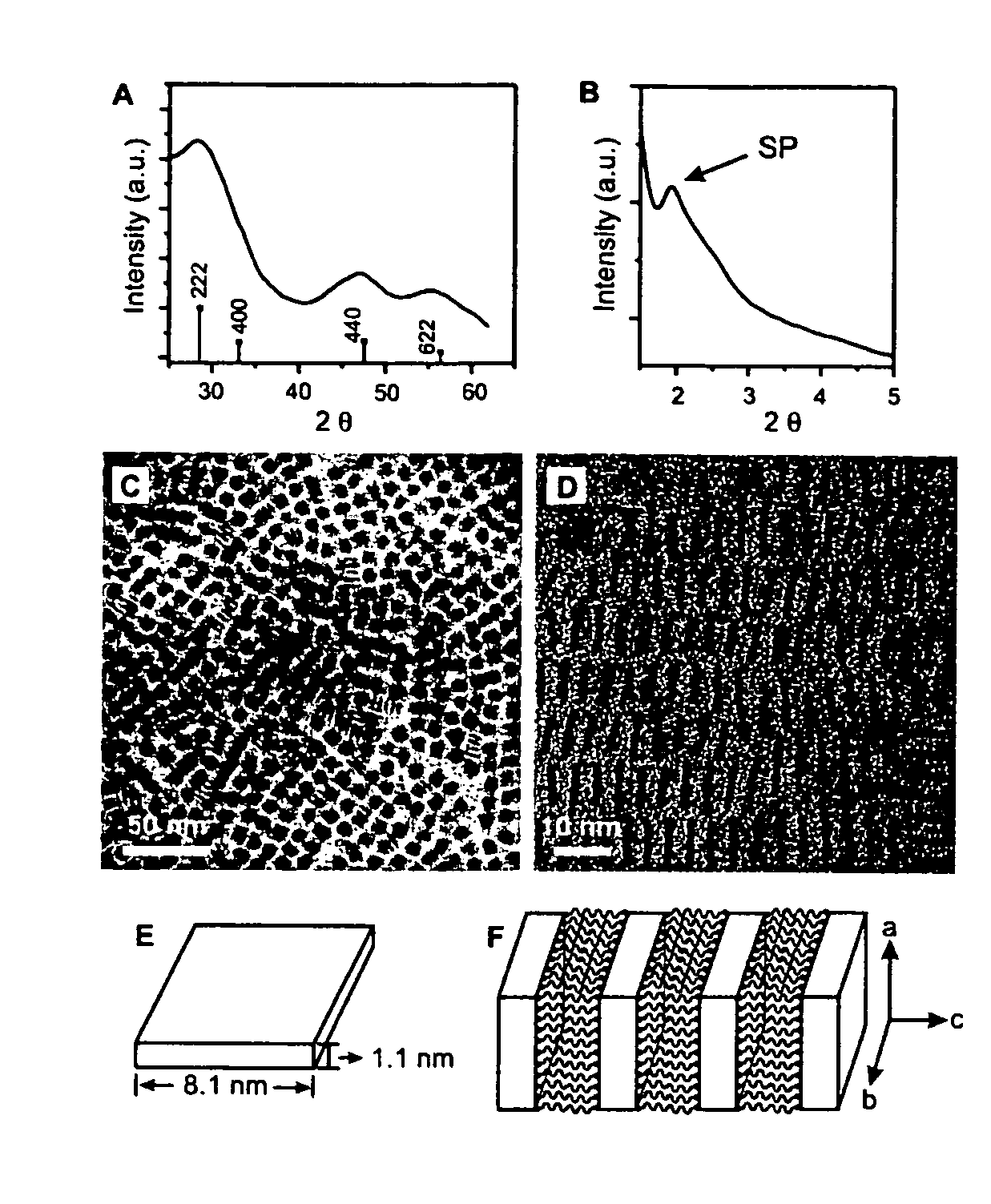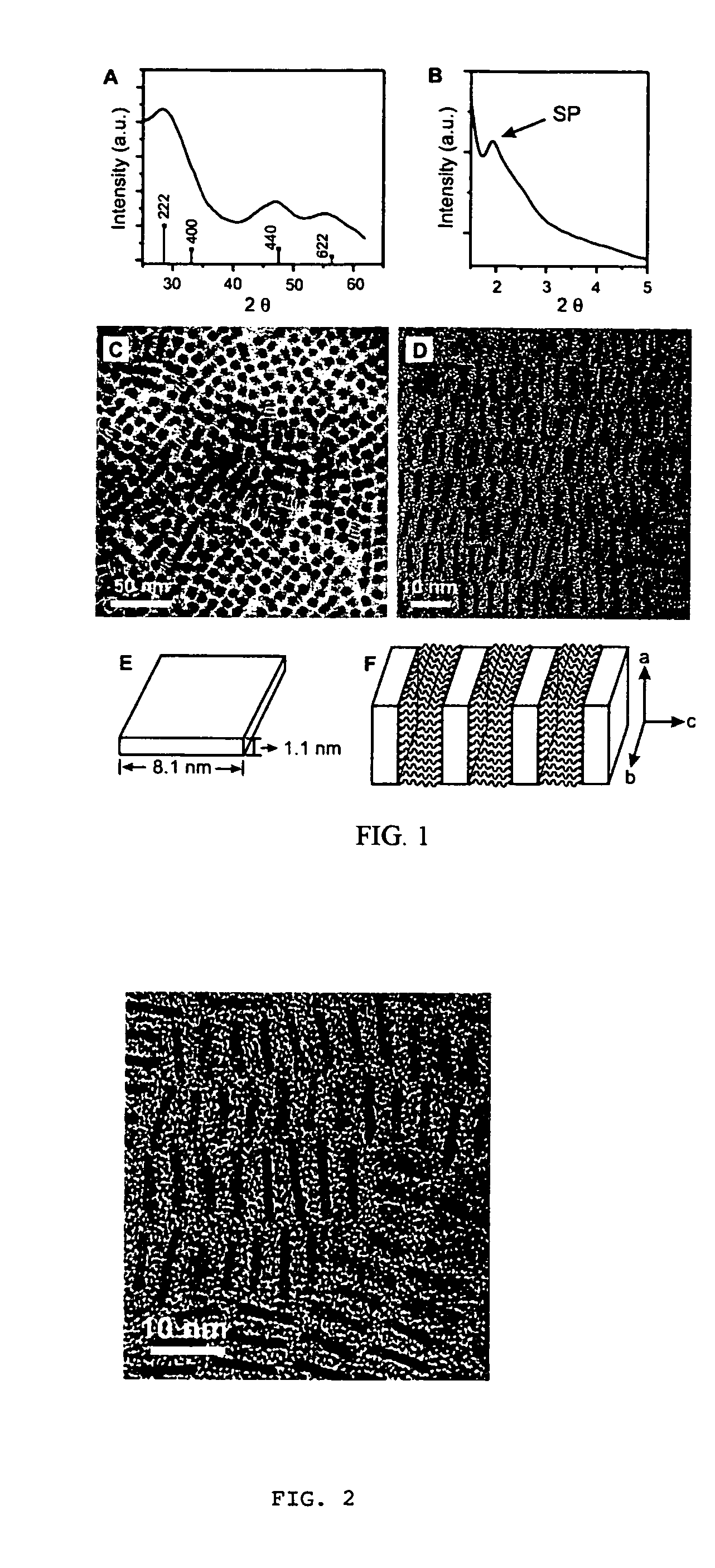Rare earth oxide nanocrystals and methods of forming
a rare earth oxide and nanocrystal technology, applied in the field of colloidal synthesis of rare earth oxide nanocrystals and nanocrystal superlattices, can solve the problems of difficult production scale-up, introduce process complication, etc., and achieves the effect of reducing variability in results obtainable, facilitating production scale-up, and simplifying the process
- Summary
- Abstract
- Description
- Claims
- Application Information
AI Technical Summary
Benefits of technology
Problems solved by technology
Method used
Image
Examples
example 1
[0042]Gadolinium-oxide (Gd2O3) nanocrystals were synthesized by solution-phase decomposition of gadolinium-acetate precursors in the presence of both coordinating and non-coordinating solvents. In one experiment, gadolinium acetate hydrate (0.75 mmol, from Aldrich) was dissolved in a solution that contained oleylamine (1.7 ml), oleic acid (1 ml) and octadecene (2.7 ml) at room temperate with vigorous stirring under vacuum (˜20 mtorr). The solution was then heated to 100° C. at 10 degrees C. / min and then held at 100° C. for 30 minutes. The vacuum was then released, and using Ar flow, the resulting solution was heated to 320° C. over approximately five minutes. The solution was then cooled to room temperature after one hour at 320° C. The nanocrystals were precipitated from the solution by adding a mixture of hexane and acetone (1:4), and then dried under Ar flow. The as-prepared nanocrystals were found to be highly dispersible in nonpolar organic solvents such as toluene and hexane.
[...
example 2
[0052]Gadolinium acetate hydrate (0.75 mmol, from Aldrich) was dissolved in a solution that contained oleylamine (1.7 ml), oleic acid (1 ml) and octadecene (2.7 ml) at 100° C. with vigorous stirring under vacuum (˜20 mtorr) for 30 min. Under Ar flow, the resulting solution was heated to 320° C. over approximately five minutes, and then the nanocrystal growth was terminated by cooling reaction solution to room temperature after 30 min or 90 min. The nanocrystals were precipitated from the reaction solution by adding a mixture of hexane and acetone (1.4), and dried under Ar flow. The as-prepared nanocrystals were found to be highly dispersible in nonpolar organic solvents such as toluene and hexane. For the reaction with 30 mins, the size of the nanocrystals was about 4 to 5 nm. The size of the nanocrystals was uniform, and highly ordered superlattice structures were formed through the assembly of these nanocrystals. For the reaction with 90 min, nanocrystals with triangular shape wer...
example 3
[0053]Europium acetate hydrate (0.75 mmol, from Aldrich) was dissolved in a solution that contained oleylamine (1.7 ml), oleic acid (1 ml) and octadecene (2.7 ml) at 100° C. with vigorous stirring under vacuum (˜20 mtorr) for 30 min. Under Ar flow, the resulting solution was heated to 320° C. over approximately five minutes, and then the nanocrystal growth was terminated by cooling the reaction solution to room temperature after 30 min in one instance and in 90 minutes in another instance. The nanocrystals were precipitated from the reaction solution by adding a mixture of hexane and acetone (1:4), and then dried under Ar flow. The as-prepared nanocrystals were highly dispersible in nonpolar organic solvents such as toluene and hexane. These Er2O3 nanocrystals were found to have a triangular shape.
PUM
| Property | Measurement | Unit |
|---|---|---|
| boiling point | aaaaa | aaaaa |
| temperature | aaaaa | aaaaa |
| temperature | aaaaa | aaaaa |
Abstract
Description
Claims
Application Information
 Login to View More
Login to View More - R&D
- Intellectual Property
- Life Sciences
- Materials
- Tech Scout
- Unparalleled Data Quality
- Higher Quality Content
- 60% Fewer Hallucinations
Browse by: Latest US Patents, China's latest patents, Technical Efficacy Thesaurus, Application Domain, Technology Topic, Popular Technical Reports.
© 2025 PatSnap. All rights reserved.Legal|Privacy policy|Modern Slavery Act Transparency Statement|Sitemap|About US| Contact US: help@patsnap.com



